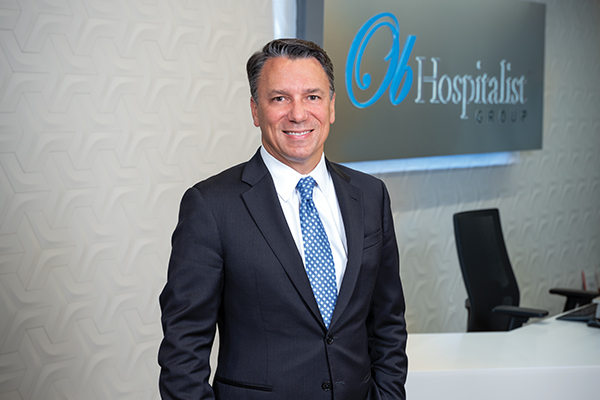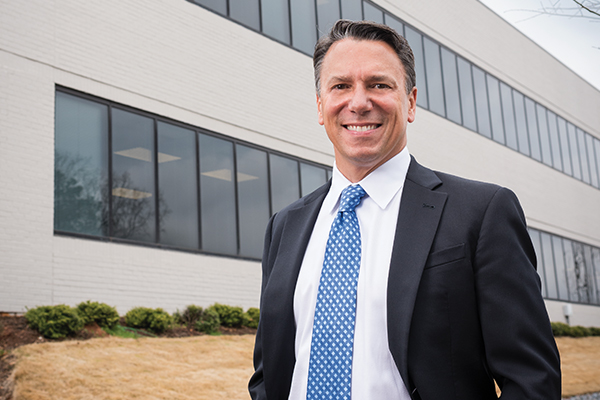Baby Steps
By providing OB-GYN departments with physicians around the clock, Ob Hospitalist Group is changing the way women's health is delivered.

As CEO of Ob Hospitalist Group, Lenny Castiglione has come across plenty of misconceptions about patient care. Here’s a common one: If a pregnant woman arrives at an emergency room, there will always be an experienced obstetrician there to help. The reality, he says, is that OB-GYNs are sometimes on call, and they have a 30-minute window to get to the hospital, even in an emergency.
“When a woman presents with severe complications, we have to intervene in less than a 10-minute period to either save the baby or save mom, or both,” says Castiglione, whose company handles an estimated 35,000 emergency interventions every year.
Ob Hospitalist Group wants to speed up that response time by providing an outsourced service to hospitals: OB-GYN departments staffed with board-certified physicians who are on site around the clock, every day of the year. The company, also known as OBHG, currently runs OB-GYN departments in more than 160 hospitals across 33 states.
OBHG aims to improve care at the hospitals it serves, and to support the work of private practice physicians. With OBHG staff at hospitals to handle deliveries—both high and low risk—private practice physicians are summoned less frequently in the middle of the night. The company says it wants to allow those physicians to use their time more efficiently, with the ultimate goal of improving patient outcomes.
OB HOSPITALIST GROUP
Business: An outsourced service to hospitals—OB-GYN departments staffed with board-certified physicians
CEO: Lenny Castiglione
Headquarters: Greenville, SC
Geographic Footprint: More than 160 hospitals in 33 states use OBHG programs
PE Investor: Gryphon Investors
RISING MATERNAL MORTALITY
There’s a gap in care, Castiglione says, and it’s reflected in the growing number of maternal deaths in the United States. A study of 48 states (excluding California and Texas) published in Obstetrics & Gynecology showed the maternal mortality rate increased nearly 27 percent between 2000 and 2014.
One contributing factor is the age of women when they give birth. Mothers today are slightly older on average, which can increase the chance of complications. In 2016, the Centers for Disease Control and Prevention found that for the first time, women in the U.S. in their early 30s had slightly more births than women in their late 20s.
Another risk indicator is the number of mothers covered by Medicaid: A 2017 CDC study found that Medicaid was the payment source for 43 percent of deliveries. Compared with women who have private insurance, mothers using Medicaid are less likely to receive prenatal care and are more prone to health problems that create pregnancy risks.
By providing board-certified obstetricians in a hospital 24 hours a day, OBHG physicians are able to act quickly to protect mothers during delivery. After adding OBHG programs to seven of its hospitals between 2011 and 2016, Ascension, a large nonprofit health system, analyzed the impact on “severe harm events”—situations that cause death or permanent injury to the mother or child. When Ascension compared data collected before and after OBHG’s programs were implemented, it found the frequency of such events dropped by approximately 30 percent on average.
For hospitals, using OBHG may also reduce their exposure to malpractice risk. “It’s very hard to defend yourself as a hospital when a woman comes with complications and a doctor wasn’t there to render immediate care,” Castiglione says.
ALLAYING PHYSICIAN FEARS
Castiglione estimates OBHG has spoken with around 3,000 U.S. hospitals about its services. Discussions can continue for years before they turn into a partnership, which isn’t surprising: Using OBHG’s programs requires a substantial investment from hospitals and a willingness to rethink decades-old procedures. “We’re changing the way that the labor and delivery unit operates,” Castiglione says.
One area of concern he hears from hospitals considering using OBHG’s services is how local OB-GYN physicians will respond.

“WE MAKE INVESTMENTS IN HUMAN CAPITAL BECAUSE A CRITICAL ASPECT OF OUR BUSINESS IS HELPING CLINICIANS AND PHYSICIANS BE BETTER LEADERS ON LABOR AND DELIVERY.”
LENNY CASTIGLIONE
CEO, Ob Hospitalist Group
For OB-GYN care, most women visit the offices of private practice physicians. They come to a hospital for labor and delivery or for treatment if an urgent health issue arises when their physician’s office is closed.
Private practice physicians want to ensure their patients receive reliable care if they show up at a hospital. They’re also wary of new competition. “There are two really big fears that community physicians have: ‘Do you have well-qualified physicians that I can trust? And are you going to steal my patients?’” Castiglione says.
OBHG tries to allay those fears. During the five to six months that it takes the company to get a team in place at a hospital, OBHG works to build relationships in the local medical community and with nurses in the hospital’s labor and delivery department, he says. “We have to gain their trust very, very rapidly for them to allow us to be a part of that patient’s care.”
Before they began working alongside OBHG physicians about eight years ago, doctors at LowCountry Women’s Specialists were skeptical. “We all had concerns about qualifications,” says Christopher Accetta, a senior partner with the Charleston, South Carolina-based private obstetrical practice. He and his colleagues questioned whether they could become comfortable with an outsourced group of doctors assisting and managing care for their patients.
Observing the work of OBHG doctors helped dispel those concerns. “It became clear that the physicians they recruited for these services were clearly seasoned and qualified,” Accetta says.
He remembers one patient who arrived at the hospital with a sudden onset of obstetrical bleeding. That required an emergency C-section, which was performed by an OBHG physician. “Competent emergency care immediately available in the hospital saved that infant,” he says.
OBHG doctors help address another challenge faced by private practice OB-GYNs: fatigue. Without an outsourced service, hospitals often rely on local OB-GYNs to be on call overnight in case of an emergency. Having OBHG’s physicians in the hospital reduces that burden. OBHG doctors manage labor and delivery for all patients from 5 p.m. until 8 a.m. They’re the only OB-GYNs on site during that time, which means Accetta and his colleagues are on call as backup.
“We come in if they need help with a C-section or if they are in a situation where two or three deliveries may happen in a short time,” Accetta says. “We are still on call, but as their backup. The number of times that we have to come in is much less than previously.”
This model also helps obstetricians extend their careers and continue delivering babies, rather than reverting to general women’s health care or retiring. “A notorious part of the obstetrical field is that as physicians become older, they become too fatigued to provide the long hours of care, and many drop obstetrics and focus on just gynecology,” he says. “It deprives patients of their expertise and experience.” Accetta, now 60, says that without OBHG’s service, he would have stopped obstetrics a few years ago. “Now I don’t see stopping it until I fully retire.”
What has surprised Accetta most is patients’ acceptance of the hospitalists. “[Patients] are more interested in having safe, competent care available readily from any physician over having their personal physician there,” he says.
THINKING OUTSIDE THE HOSPITAL
Since it was founded in 2006 by OB-GYN Chris Swain, Ob Hospitalist Group has grown with support from private capital. Summit Partners acquired the company in 2010 and later sold it to Ares Management in 2013. In 2017, OBHG joined Gryphon Investors’ portfolio.
The deal closed in about four months, in part because Gryphon had been watching hospital outsourcing closely, says Kevin Blank, partner and general manager for health care at Gryphon. “In today’s environment speed really counts,” he says. “It’s critically important to do your homework so you’re prepared to move.”
Health care is one of Gryphon’s four investment areas, and it has been a theme in Blank’s career—he previously served as president of Women’s Health USA.
Gryphon was tracking industry trends that favored OBHG, including hospital consolidation and standardization. As large hospital systems continue to acquire smaller hospitals, they look for ways to standardize approaches across their holdings, says Blank, who is executive chairman of OBHG’s board.
When Gryphon acquired OBHG, the company served approximately 100 hospitals—today it’s in more than 160, and the number of OB-GYNs it employs has increased from 500 to more than 700.

“[PATIENTS] ARE MORE INTERESTED IN HAVING SAFE, COMPETENT CARE AVAILABLE READILY FROM ANY PHYSICIAN OVER HAVING THEIR PERSONAL PHYSICIAN THERE.”
CHRISTOPHER ACCETTA
Senior Partner, LowCountry Women’s Specialists
At the outset, Gryphon saw that investing in leadership training would bring value to the business. Gryphon’s internal human capital team worked with an outside strategy firm to put OBHG’s management team through two days of in-person training, followed by a six-month coaching process. “We don’t consume a lot of capital. We don’t build buildings. We don’t have factories. I’m not acquiring other companies or other groups,” Castiglione says. “We make investments in human capital because a critical aspect of our business is helping clinicians and physicians be better leaders on labor and delivery.”
Castiglione, a member of the board of directors, says OBHG has benefited from the rest of the board’s acumen. In addition to three Gryphon leaders, the board includes industry experts, an Ares partner and OBHG’s co-founder.
“These are professionals that have been in the industry for 20, 30 years … They can see the landscape in front of us and help us navigate that and help us open doors,” Castiglione says. “But probably most important, they can help us understand what mistakes we are going to make along the way, and how to avoid them.”
INDUSTRY IN INFANCY
Hospital outsourcing businesses have attracted PE investment for years, and that trend will continue, according to AJ Shekar, a vice president at investment banking firm Provident Healthcare Partners. Early investments in this space included anesthesia services and emergency department management, both of which have experienced significant outsourcing.

“ALL OF THE GOOD THINGS IN LIFE THAT I WANTED AND I THOUGHT I’D BE GETTING FROM SELLING DRUGS, I GOT FROM WORKING.”
DION DREW
Lead Supervisor, Greyston Bakery
With downward pressure on health system reimbursement, hospitals turn to outsourced physician services as a way to gain efficiencies, says Shekar. He expects that trend will encourage PE firms to expand their investments in outsourced health care service providers.
Women’s health represents a more recent area of interest for private equity. In a deal that closed in 2017, Shekar’s firm worked with Audax Group, which created Axia Women’s Healthcare through a roll-up of two companies. The following year, private equity firm Madison Dearborn Partners acquired Solis Mammography, one of the largest independent providers of breast cancer screening and diagnostic services. Advances in mammography technology and the increasing awareness of breast cancer help make this a compelling area for investors, says Shekar. But it’s also part of a greater focus on women’s health services overall.
“Obviously there’s a pronounced need for those services across the country and kind of a lack of access to care in many parts of the U.S. But I’d say that, overall, it’s a newer sector from a consolidation perspective,” he says.
He expects activity to continue across health care services for women. There are many large outsourced physician services providers in the market that act as consolidators, and acquiring women’s health care services could add to their offerings. “I wouldn’t be surprised if at some point down the road they seek to continue expanding their services out of what’s historically been the core focus of anesthesia, emergency department management and radiology,” Shekar says.
MAKING AN IMPACT
With year-to-date revenue approaching $280 million as of February, Castiglione expects the company’s annual revenue to be about 20 percent greater than in 2018. He estimates OBHG can expand its client base by more than 40 hospitals a year, and he would like to see the company handle more labor and delivery, freeing up physicians in private practice to do what they do best. Currently, OBHG performs about 15 percent of total deliveries in the hospitals it serves, but Castiglione believes it could help with a much larger percentage. It could also play a role in providing follow-up care after delivery.
“As the industry starts to evolve, I think you’re going to see the specialty of OB-GYN change,” he says. “Meaning, how does the community OB-GYN allow the hospitalist to do more on their behalf, in the hospital?”
That mission creates a sense of shared purpose at the company, which is reinforced at OBHG board meetings. They each feature a 10-15 minute discussion of how OBHG provided meaningful care that affected the life of a mother or baby. “I’ve been on 15 boards in my career and never experienced that,” Blank says.
In this line of work, something heroic happens every day, he adds. “There are moments of truth in how you manage that patient that can make a real difference.”
This story originally appeared in the May/June print edition of Middle Market Growth magazine. Read the full issue in the archive.
S.A. Swanson is a business writer based in the Chicago area.


